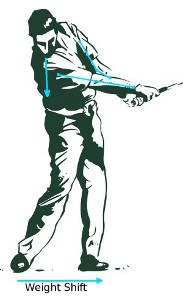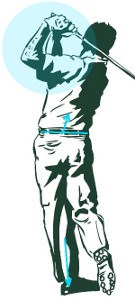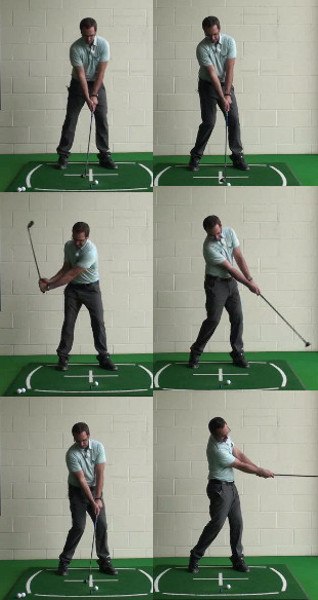5 of 7 | < Previous Next >
Once you reach the top of the backswing, here's what should happen:
The downswing is proof that the golf swing does, indeed, work from the bottom up.


- The left heel, which has lifted slightly on the backswing, returns to the ground.
- The left hip rotates toward the target, pulling the torso, shoulders and arms through toward the ball.
- The hips and torso continue rotating, the arms lagging slightly behind the chest until impact.
- Weight begins shifting from right foot to left.
As for the head… Keep your eyes focused on the back of the ball throughout the swing and it will react accordingly.

Top Tips for Golf Hybrids Downswing
One of the big selling points used to convince golfers to choose hybrid clubs rather than fairway woods or long irons is their ease of use. Hybrids tend to be rather easy to hit – at least when compared to the other options available. With that said, you still have to make good golf swings if you want to get good results. If you make a poor swing, it won't matter what type of club you happen to be holding, as your shot is going to miss its mark in the end.
To make sure you are getting the best possible performance out of your hybrids, this article is going to focus on a crucial part of your hybrid swing – the downswing phase of the action. During the downswing, you need to move your body and the club together properly in order to deliver the club into the back of the ball correctly. Only when the club and your body are working together as a cohesive unit are you going to be able to accomplish the results you have in mind. Many golfers get off track during the downswing, with either the body or the club – or both – failing to perform. By the end of this article, you should have a clear picture of exactly how you need to execute the downswing in order to strike beautiful hybrid shots.
Of course, it probably isn't a surprise to learn that the swing you are going to make with your hybrids is very similar to that which you should use with the rest of your long clubs. You should always seek out simplicity in golf, and there isn't any better way to keep your game simple than to maintain the same technique across as many clubs as possible. Your swing is going to have to change slightly from club to club in order to account for the differences between those clubs, but any adjustments you make should be as subtle as they can be. In the end, a simple golf game is going to be a reliable golf game.
Once you get comfortable using your hybrid clubs, you will find that they are useful in a long list of situations. For one thing, you can use them effectively off the tee to find narrow fairways on shorter holes. Also, you can attack par five greens in two, play tee shots on long par threes, and even hit little chip shots from off the edge of the putting surface. Hybrids have experienced a tremendous growth in popularity in recent years, and much of that growth is due to their impressive versatility. You don't have to settle for the limited performance of long irons when you can put the many benefits of hybrid clubs to work in your bag.
All of the content below is based on a right-handed golfer. If you happen to play left-handed, please take a moment to reverse the directions as necessary.

Preparing for Your Downswing
As you already know, you can't just start your swing with the downswing phase. First, you need to get to the top of your swing, which means you have to both take your stance and make your backswing before the downswing can occur. In this section, we are going to make sure you are able to perform those first two tasks successfully. Without setting the stage properly for your downswing, you will be destined for failure.
To get started, let's quickly look at the key features of a proper stance when hitting a hybrid club.
- Feet outside shoulder width. One of the most important features of a quality stance for a hybrid club is setting your feet just outside of the width of your shoulders. This is crucial because it is going to help you stay balanced throughout the swing. If your feet are placed too close together, you'll struggle to stay balanced while still making an aggressive swing. Many amateur golfers stand with their feet too close together with all of their clubs, which is why balance is such a point of trouble for so many golfers.
- Stick your backside out. This might seem like an odd point to make, but it is important nonetheless. At address, especially with your long clubs, you need to feel like you are sticking your backside out slightly as you stand over the ball. Why does this matter? The act of sticking out your backside is going to flatten the lower part of your back, allowing you to make a better turn. Also, you will engage the big muscles in your legs when you make this adjustment, and those muscles will go a long way toward powering your downswing.
- Keep your chin up. You might have heard that you need to keep your head down when playing golf, but such advice is a bit misleading. While it is good to keep your eyes on the ball as you swing, your chin needs to be up away from your chest in order to promote a full rotation through the ball. Start with your chin up and your eyes down and work hard to stay in that position as the swing develops.
Once you are in a good position over the ball, you then need to execute a clean backswing. Unfortunately, the backswing is often overlooked by amateur players, as they feel that it isn't important enough to focus on during practice. Nothing could be further from the truth. While you aren't actually hitting the ball during your backswing, the moves you make are going to set the stage for the kinds of shots you can hit. Let's take a look at three key parts of the backswing which you need to get right if you'd like to strike a great shot in the end.
- A quiet takeaway. For some reason, this might be the hardest part of the entire golf swing for amateur players to master. It is ironic that this part of the swing gives the average player so much trouble, since it is actually a simple move which requires very little from you. To perform a great takeaway, all you need to do is turn your shoulders away from the target while keeping your hands quiet. It is that second part that seems to give players so many problems. Rather than using quiet hands and wrists during the takeaway, most players want to engage their hands to put the club in motion. Doing so is going to lead to a number of issues. The biggest of which is that the club will be likely to move to the inside, setting the stage for an over-the-top swing, and a slice. Keep your hands out of the takeaway and your game will quickly improve, no matter what club you are holding.
- A full turn. You probably expected to see this point on our list. To hit solid shots, you need to make a nice turn away from the ball. While a big shoulder turn is valuable, it is important to mention that you don't want to take this too far. How will you know that you've gone too far? Simple – when you start to lose your balance, your turn is out of control. A big turn is important, but balance is even more important. Work on rotating your shoulders as far away from the target as possible without impacting your balance in a negative way.
- Smooth tempo. The speed of your backswing is important as well. You don't want to rush through this part of the swing just to get it over with, but you also don't want to take so long that your body gets tense and tight. A smooth, even tempo from address on up to the top of the swing is ideal. Pay attention to the pacing of your backswing on the driving range and iron out any trouble spots so that you are left with a beautiful rhythm.
We have covered a lot of ground in this section, but it has all been important. If you are going to make a downswing with your hybrid clubs that actually leads to quality results, one of the first things you need to do is find a way to get into a great position at the top. By combining a solid stance with a fundamentally-sound backswing, you can do just that.

The Downswing, Step-by-Step
It is now time to work through the downswing that you are going to make with your hybrid clubs. We have provided you with some tips to build a great stance and make a proper backswing, so hopefully you have taken that advice to heart. In this section, we'll walk through a step-by-step process of how the downswing should unfold. If you are able to follow along successfully, impressive hybrid shots should be right around the corner.
Of course, it is going to be easier said than do to mimic the instructions contained below. You'll need to spend plenty of practice time working on these tips before you will see them pay off on the course. Without any further delay, let's get started!
- Hips go first. You aren't going to make a great downswing unless you start with your hips rotating toward the target. This is the best way to initiate the action, because it is going to engage your lower body right away. Countless amateur golfers fail to use their lower bodies correctly during any part of the swing, which leads to a weak, inconsistent swipe at the ball. Start your downswing by opening your left hip up toward the target and everything else should fall into place nicely from there.
- Leave your hands back. It will be tempting to bring your hands (and the club) along quickly as soon as your hips start to turn toward the target. Don't make this mistake. If you let your hands come along at this early stage, the club is going to get out in front of your chest too soon, and you will probably swing across the ball from outside-in. This is how many golfers create their slice. As your lower body starts turning, keep your hands out of the equation and let them lag behind a bit. They will catch back up naturally on their own, later in the downswing.
- Keep turning through the shot. Unfortunately, many golfers who manage to start the downswing correctly get off track when they give up on their rotation only part way through the swing. Once you start your turn, you need to commit to it all the way through the swing. Fire your hips through the ball and just keep on going. As you keep turning, your hands and the club will automatically be pulled down toward impact by the rotational force that you have created.
- Fire the right hand. It is important that you keep your hands out of the downswing equation early on. However, once the club gets down close to the ball, you should feel free to fire away with the right hand in order to strike the ball with authority. The key here is to hold off on this move for as long as possible. Let your swing get well down toward the ball before you turn the right hand loose and let it release the club through impact. When timed correctly – which will not be easy at first – this type of swing can have an amazing effect. Not only will you hit more powerful shots than ever before, but those shots should be more accurate as well.
- Don't forget to finish. The finish of your golf swing is important, even though the ball is already gone. By swinging all the way into a full finish, you are going to prove to yourself that you have rotated nicely, and that you have stayed on balance. Usually, when a golfer cuts his or her follow through short, it is because that player has done something wrong somewhere in the swing. By making a point of reaching a full finish after every hybrid swing, you will have a built-in way to check on your mechanics.
As you can see, there is nothing particularly complicated about the downswing with a hybrid club. You are going to start the downswing with a rotational movement toward the target in your lower body. From there, the force of that rotation is going to lead the way, pulling your body into the right places. When you bring together great rotation with a free release of the club head through the ball (thanks to your right hand), it will be possible to strike incredible shots.
5 of 7 | < Previous Next >





